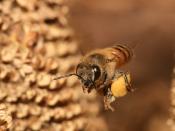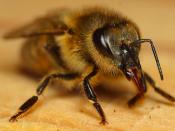Effects on Bees
Sonya J. Prado
Sacramento State University
April 14, 2014
Honey bees play a critical role in agriculture. The study of the honey bee has shown the true complexity and efficiency of their colony. Each member works together in a nearly flawless environment of productivity. Honey bees are studied extensively to study other aspects of biology because their genetics can be easily controlled. An analysis of three research articles on effects on honey bees will identify what, how, when, and why it was done and who it was done by.
An experiment by Barron et al. (2009) was done on honey bees by treating them with freebase cocaine, OA hydrochloride or mianserin hydrochloride by applying the compounds dissolved in dimethylformamide (DMF) to the dorsal thorax of forager bees using a glass of micro capillary while they fed at sucrose or pollen feeders.
The first experiment tested the effects of cocaine and mianserin hydrochloride treatment on dance behavior.
The observation was done by using colonies of about 8,000 bees housed in a glass-walled observation hive. Their round dances were video recorded during a 50 minutes period after individually paint-marked foragers were trained to a 1.5moll-1 sucrose feeder 10m from hive. Dance observation began 20 minutes after treatment. During the observation period, the number of visits by each bee to the feeder was also recorded. Videos were later analyzed to score how many feeder visits caused dances on return to the hive and the rate of dancing- number of dance circuits per minute. To test whether cocaine influenced dance behavior by affecting biogenic amine signaling, the authors examined whether mianserin treatment could reduce the effects of cocaine on dance behavior.
The second experiment tested the effect of cocaine on loco motor behavior. Forager bees were caught at a sucrose...


